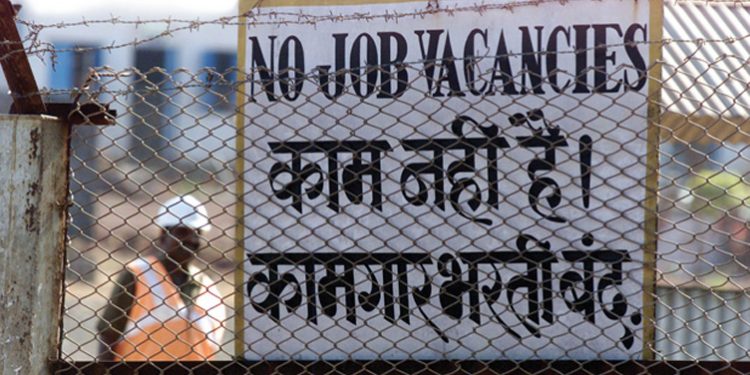New Delhi: The yet-to-be-officially-published periodic labour force survey (PLFS) report of the National Sample Survey Office (NSSO) has some worrying data for the country, a business medium has reported. The ‘Business Standard’ Thursday reported that unemployment rate assessed under PLFS for July 2017 to June 2018 stood at 6.1 per cent — the highest in 45 years. Such unemployment rate was last reported in 1972-73, according to data ‘Business Standard’ has accessed.
The data portend to affect the electoral prospects of Prime Minister Narendra Modi-led NDA government as growing unemployment in the wake of demonetisation and the introduction of Goods and Services Tax has remained a thorn in its side. When Modi came to power in 2014 he had promised to galvanise the economy, and boost employment prospects for the millions of young Indians entering the jobs market each year.
However, the PLFS data, it is reported, show that urban joblessness stood at 7.8 per cent while rural joblessness stood at 5.3 per cent.
Congress president Rahul Gandhi attacked Modi over the “leaked job creation report card”. “NoMo Jobs! The Fuhrer promised us 2 Cr jobs a year. 5 years later, his leaked job creation report card reveals a National Disaster. Unemployment is at its highest in 45 yrs. 6.5 Cr youth are jobless in 2017-18 alone. Time for NoMo2Go,” Rahul tweeted with the hashtag ‘HowsTheJobs’.
The CPIM has in an official statement alleged that the Modi government had refused to release the Labour Bureau’s annual survey of 2016-17, too. “This suppression of data is a clear admission on the part of the Modi government that its policies have resulted in greater misery for our people. India’s youth, which is our asset, is now being wasted. It also exposes the utter failure of the BJP-led government to deliver on its promise of providing two crore jobs every year, that is, ten crore new jobs during the last five years. The CPI(M) demands that all data must be released immediately. These must be placed and discussed in the Parliament. The people of the country have a right to know about the grim realities facing them,” the statement read.
The statistics ministry had in its last such survey report, shown that unemployment rate rose to 5 per cent in 2015-16 from 4.9 per cent in the previous year and 4 per cent in 2012-13.
Unemployment among males stood at 4.3 per cent and 8.7 per cent among women in 2015-16, the government data showed.
Centre for Monitoring Indian Economy (CMIE) had earlier stated stated that the country lost 11 million jobs last year.
The government, however, has stated that the NSSO report cited is not the final one. Niti Aayog Vice Chairman Rajiv Kumar, who had previously mounted a defence of lowering of UPA-era GDP growth rates, at a press conference Thursday said the report “is not finalized”. “It is a draft report,” he said.
He refused to comment on the content of the news report, but said the government will release its employment report by March after collating quarter-on-quarter data.
The PLFS report, the first comprehensive assessment of India’s employment situation conducted since demonetization, drew attention particularly after the head of National Statistical Commission PC Mohanan and his colleague J Meenakshi quit their jobs saying they were unhappy with the non-publication of jobs data that was due for release in December. Mohanan alleged that other state agencies were interfering with the report over backdated GDP data.
Government officials, in turn, have said that although the NSSO had submitted the report, it was up to the government to decide when it should be released and that the release of data was being delayed as the findings were so dismal, and plans were afoot to incorporate data on persons included in the social security network to improve the overall picture.
Unemployment in India has been rising since 2012 but the attempts to suppress the publication of data were not a solution. “It will only create more suspicion about the intentions of the government,” Reuters has quoted former chief statistician Pronab Sen as saying.
A Curious Appointment
Former Enforcement Directorate (ED) chief Sanjay Kumar Mishra has been appointed a full-time member of the Economic Advisory Council to...
Read more





































